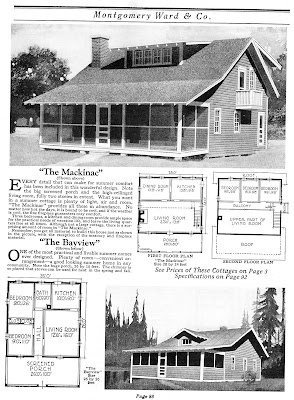House trailers have always had something of an image problem. People like to think of dwellings as permanent--the presence of a chassis and wheels goes against that. Then there are the types of people that live in transportable housing...transients? People of lower economic status? The reality is that mobile homes and semi-permanent modular housing serves a need--affordable, quick, mass-produced housing for people who need it. Though most people still think of a trailer park as something like this:
Sadly, it doesn't have to be, and it wasn't always this way.
Humble Beginnings
The house trailer started off not as a permanent home, but as a vehicle for having a home away from home that was mobile. In 1919, Glenn Curtiss (of Curtiss-Wright airplane fame) built a high-end custom trailer he called the "Aerocar". It was patterned after a yacht. Inside were four Pullman-style berths, a galley, a glass roof, wardrobes, running water, and a telephone to the car ahead. This attached to his Model-T Ford.
 |
| Glenn Curtiss with his Aerocar, ca. 1922 |
The average American weekender, however, could not afford such luxurious accomodations. Nevertheless, Americans have insisted on taking their cars camping. An entire industry developed around manufacturing folding trailers and autotents. These devices (often homemade) attached to the car and served as a makeshift dwelling for the family desiring the idyllic pastime offered by camping. The "Prairie Schooner" was one of the most popular models.
 |
| A prairie schooner |
These tents soon evolved into "trailer tents" that were towed behind the car but featured tent-like features such as canvas roofs. Many of these were do-it-yourself affairs.
The House Trailer Takes Shape
In the 1930s, house trailers began to take on the form we now see today, with fixed sides and roofs. Airstream and Silver Dome were two companies that pioneered this new idea. This was also the time period when more people began actually LIVING in trailers, due to the relatively low cost and the transient nature of the dwelling, at a time when a large number of the workforce was transient. Below are some fun examples of the house trailer from the 1930s.
 |
| The Patrick Collapsible House - a hybrid tent/trailer |
 |
| William Stout's Folding House |
 |
| The Road Chief |
 |
| Schult Trailer Co.'s 17-foot model, ca. 1940 |
 |
| "Trailer of Tomorrow", by Carl X. Meyer |
 |
| The "Tourhome". It telescoped up and out. |
But where to put them?
As house trailers got more complex and elaborate, parking them became more complex. This ushered in the rise of the trailer park. Initially, municipalities offered free trailer park sites (some with electrical and plumbing hookups), hoping to take advantage of the trailer occupants business in their respective communities. This, largely, did not work. Rules had to be made about length of occupancy, and issues of sanitation were often a problem. Private parks prevailed, including some with sights of national chain-dem, though most were Mom-and-Pop affairs.
 |
| A typical 1930s trailer park. |
 |
| Layout for a trailer park, ca. 1935. Very idyllic! |
 |
| A makeshift park in Detroit, mid 1930s. Parks like these caused numerous public health problems. |
An amusing account of trailer park life:


















































